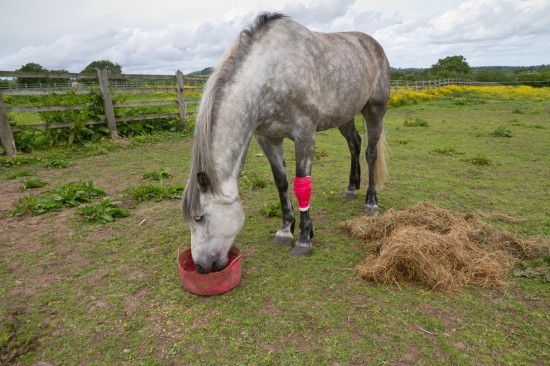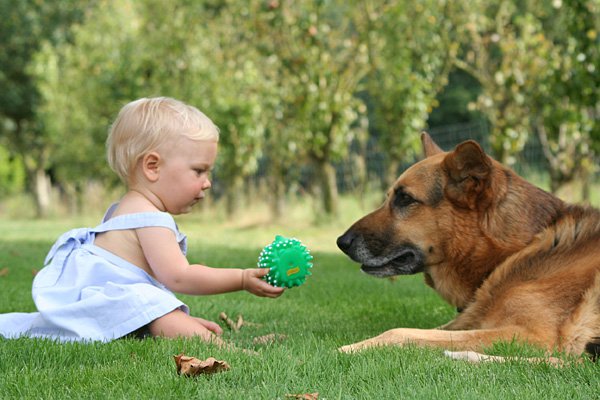People frequently ask how a Dog Behaviorist and Dog Obedience Trainer relates to dogs and earns their respect and control . . . and especially that of the Dominant Dog. The first part of that answer is simply stated but difficult for many people to internalize and act upon: To relate to a dog, you must first see and treat him fully as a DOG!
Before you can deal with a dog dominance issue at home or in dog obedience training, you must recognize that dog behavior and dog communication are NOT in line with human psychology. After all, your dog is a CANINE (canis familiaris of the Family Canidae), and not homo sapiens. So he thinks like a canine, not like a person. Your dog responds as one might in a wolf pack, not as a human family member. He or she has real emotions, but they are canine emotions, not human emotions, and not to be mistaken as such.
The basic communication system of dogs involves three critical elements --silence, submission, and leadership -- sometimes referred to generally as the dog whisper technique, with elements of wolf pack communication. We will use these elements in this and subsequent dog training articles about solving Dog Dominance problems. You and I need to understand, read, and use your dog抯 own communication system for optimal effectiveness in working with him.
Dogs have an inherent Pack Psychology which governs their thinking and actions. In a pack, there is one dominant one, and the rest are all followers. There is one Alpha male and one Alpha female. To relate to a dog from a position of strength, respect, and control, YOU must be the Alpha Leader, the Pack Leader, and you must use pack psychology and pack communication.
Often we see dominant dogs taken home as young pups, because people are amused by their spirited behavior. Actually, they are usually the first puppies chosen, the proverbial Pick of the Litter. However, if this high-spirited nature is not controlled, then things get out of control quickly . . . becoming worse over time . . . until the situation sometimes becomes dangerous. Dominance can lead to violence.
So you might look for a mature dog, such as a Shelter Dog or Rescued Dog. However, looking for a less dominant pet is not so easy in shelters. There a dog抯 true nature is difficult to discern without the aid of an experienced person. While in the shelter, the dog rarely has an area or anything that is under the dog抯 control, so there is little opportunity to observe possessiveness and dominance problems.
Nor are dogs cooped up in shelters able to burn off excess energy. It抯 very hard for an untrained eye to differentiate between an excited 揚lease take me home?and the more troublesome 揑 want to control you!?of the hyper-active, dominant canine.
But the dominance problem quickly becomes evident when you go home and relax, for dominance shows up where perceived weakness is present. For example, petting your dog when it is submissive (e.g., sitting or lying down) is appropriate and desirable, but not when it is in an aggressive or dominant stance.
If you display any sign of soft laxity at the wrong time because of your affection, that will be interpreted by your dog as weakness . . . and then, 揔atie bar the door!?With dominant types, you simply cannot afford to let down your guard or to make an exception 搄ust this once?because the pup is so cute.
You must establish and maintain firm, consistent control of the Dominant Dog at all times. These eye-catching, spirited animals are highly intelligent and have great potential, but they also are usually very willful, stubborn, born leaders who seek to control you, other animals, and their environment. They want to rule the roost!
You cannot give them an inch . . . or they will take it, and take it, and take it . . . over and over, time and again. These dogs are persistent!
For example, one friend had an Old English Sheepdog puppy, an Alpha Female about eight months old, who had a very bad reaction to a toxic flea dip back in 1976. As the puppy started to tremor, the frightened owners lifted their darling onto the foot of the bed, both for her comfort and to ease their own backs as they nursed her.
MISTAKE! That one incident led that puppy and her litter-mate to sneak onto the bed whenever possible . . . a pattern the owners never succeeded in terminating for the rest of the dogs?lives!
Too many owners just coddle the two-and-three month old 揵abies?and think that puppy training can start later. NO! The intelligent, spirited ones, especially, must be 搕rained?from day one with consistency, with You clearly as the Master!
Because of their high intelligence, they are ready much earlier than others for more formal types of training, too. Training helps remove boredom and release energy, while giving the prideful animal a proper goal for which to strive, and achievement about which to strut with regal, dignified, proud bearing and the clear satisfaction of pleasing.
DON扵 MOVE WITH THEM, YOU LOSE THEM!
I, too, have had a trying personal experience with an aggressive Alpha Pup. I brought home a beautiful Rescued Dog, an eight-week-old retriever puppy from the Humane Society. She turned out to be the most willful and stubborn dog I have ever seen, striving for dominance in all things! There is no way she would have lasted in a 搉ormal?home. However, because of my sheer determination with consistent, proper training, she is becoming a loving, playful, and obedient sweetheart who, without loss of any spunk or pride, nevertheless submits to my command by a mere glance. I am her undisputed Pack Leader.
Still, it wasn抰 easy to get her to that state. In great frustration, I eagerly sought the advice of two other trainers with vast puppy experience. So I say to beleaguered Owners of aggressive, dominant puppies and dogs, 揇on抰 be embarrassed. This can happen to anyone! Never be ashamed to ask for help from a Dog Trainer.?(Just make sure they really understand pack psychology.)
If you have a dog dominance problem, there IS a specific training technique that will work for you, and it centers on FOCUS. It applies the communication system of 搒ilence, submission, and leadership?and is a dog training technique which is effective with most dog dominance issues. [It抯 much more effective and pleasant than hitting and yelling!]
So get help with control of the dog dominance behavior, and restore a right relationship with your pet, and peace and harmony in your home!
PawPersuasion © Copyright 2006. This article may be freely distributed if Rena Murray抯 author resource box and this notice stay attached.

 Tabby Cat Colour And Pattern Genetics
Tabby Cat Colour And Pattern Genetics
 Summer Safety Tips For Pets
Summer Safety Tips For Pets
 Getting Your Cat Fit And Healthy By Having Fun
Getting Your Cat Fit And Healthy By Having Fun
 What Is Ocd? How Does The Condition Affect Horses?
What Is Ocd? How Does The Condition Affect Horses?
 How To Proceed If Your Pedigree Dog Is Diagnosed With A Hereditary Health Condition
How To Proceed If Your Pedigree Dog Is Diagnosed With A Hereditary Health Condition
 Learn to How to Control the Aggressive Behavior of Dogs!
Learn to How to Control the Aggressive Behavior of Dogs!
 Biotopes; Putting Your Fish Into A Natural Environment
Biotopes; Putting
Biotopes; Putting Your Fish Into A Natural Environment
Biotopes; Putting
 5 Common Houseplants And Flowers That Are Most Toxic To Cats
5 Common Housepla
5 Common Houseplants And Flowers That Are Most Toxic To Cats
5 Common Housepla
 Dog Breeds Most At Risk Of Developing Cherry Eye
Dog Breeds Most A
Dog Breeds Most At Risk Of Developing Cherry Eye
Dog Breeds Most A
 What To Do For A Dog That Is Grieving
What To Do For A
What To Do For A Dog That Is Grieving
What To Do For A
 Understanding pet bed routines
Understanding pet bed routines
Every time you
Understanding pet bed routines
Understanding pet bed routines
Every time you